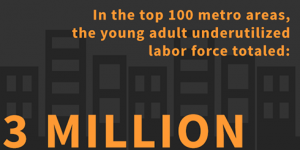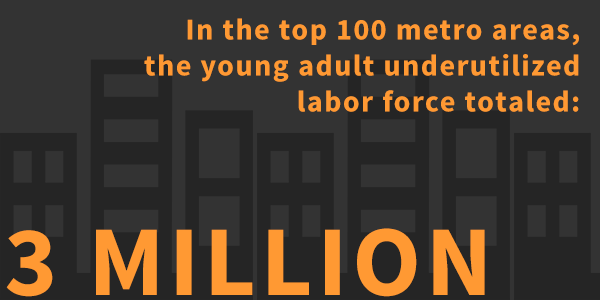Youth Unemployment Figures: January 2015
 •
•
The Time To Act Is Now.
The latest employment figures are out today. While the overall unemployment rate remains steady at 5.7 percent and will likely be heralded as good news, for young Americans, the numbers tell a vastly different story.
The employment picture is grim for teens and young adults.
According to the latest report from the U.S. Bureau of Labor Statistics, nearly 1 in 5 teenagers who want to work don’t have jobs.
And for 20-24 year olds, their unemployment rate of 9.8 is nearly twice the national average. This state of affairs was considered unconscionable for the overall population during the Great Recession, but is, unfortunately, the status quo for young Americans who have experienced unacceptably high levels of unemployment for several years.
The latest numbers underscore the urgent need to find solutions to the youth unemployment crisis and find cross-sector solutions – the focus of the third National Opportunity Summit happening in Washington D.C on Feb. 26.
The time to act is now.

As of January, 18.8 percent of American youth ages 16 to 19 are unemployed. When those numbers are disaggregated by ethnic group, the picture is even bleaker.
While 16.4 percent of white teens lacked jobs, nearly twice that number – 29.7 percent – of black teens were unemployed, as were 22.1 percent of Hispanic youth.
Youth unemployment disproportionately hurts low-income teens and young adults. Because of research like Andrew Sum’s 2014 report: The Plummeting Labor Fortunes of Teens and Young Adults, we know that the lower a young person’s household income, the more likely they will be unemployed. The very youth who need jobs the most are being shut out of the market.
And young Americans face another huge problem that is not fully captured by the official employment reports: labor force underutilization. This includes the officially unemployed who don’t have a job and are actively looking, as well as the “hidden” unemployed who desire a job but are not actively looking and the “underemployed” who are working part-time, but want or need full-time work.
In 2011, the young adult underutilized labor force in the nation’s top 100 metropolitan areas totaled 3 million.
It doesn’t have to be this way. There are effective strategies and programs all across the country that are helping young people embark on meaningful education and career pathways and get good jobs. Career and technical education; apprenticeships and internships; bipartisan legislation that promotes skill building and job training; mentoring relationships; and entrepreneurial ventures are just some of the ways employers, schools and nonprofits and youth leaders are working together to ensure that all of our talent is on the field. We will explore all of these solutions, and more, at the National Opportunity Summit.
We know that when our youth do well, we all do well.
If you are unable to join us at the National Opportunity Summit, there are still plenty of ways to participate, including following on social media, #OppSummit; sharing your own #OpportunityMoment; and joining the Call to Action we will be announcing at the Summit.
Working together, we can dramatically reduce the rate of youth unemployment. Let’s get to work.









